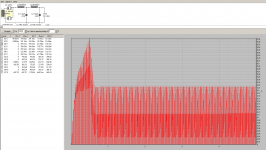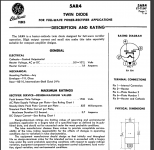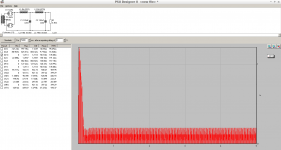Sorry for the confusion guys, that's what happens if you're working on a project that goes on for years, and the power supply design is long in the past...
I remembered the filter chain values wrong, here's the correct schematic:

So the filter chain really is: 5H - 120µF - 5H - 120µF
choke data: 5H, 87ohms DCR, 300mA
mains transformer: 480-0-480V, off-load voltage measured 495-0-495, PSUD calculates 3% regulation and 96ohms DCR
Using these values, the PSUD simulation looks much safer:
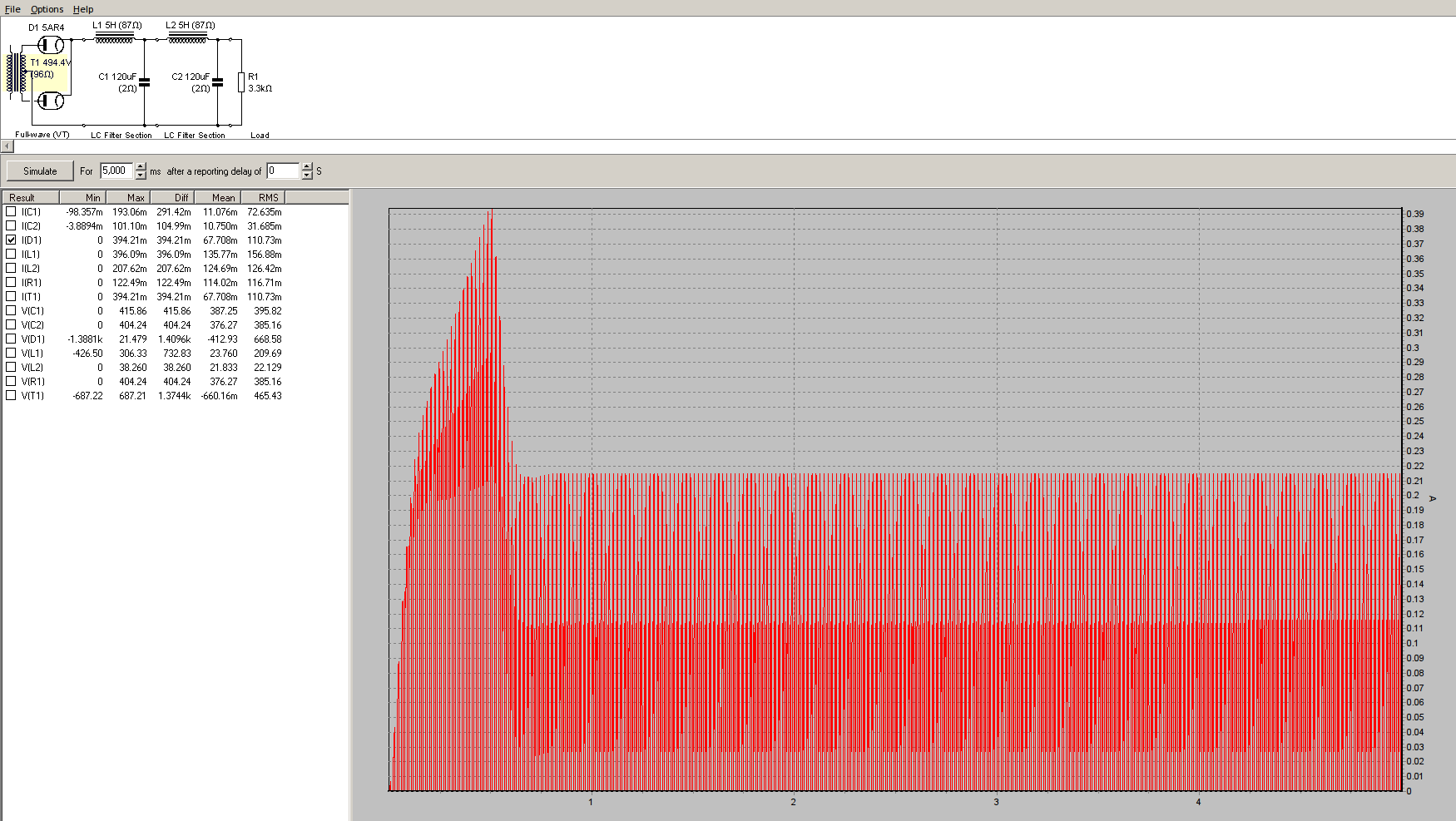
The start-up peak current is now down to 394mA, well below the 750mA limit of the GZ34.
I tested the arcing channel with the known good JJ GZ34, first with the bulb limiter, then with full voltage. No sign of arcing. I mistreated it a bit by varying the startup conditions (full cold, rectifier cold and tubes hot, hot restart with the rail down to a few volts...) - again no sign of arcing.
I hope that a faulty JJ GZ34 is all behind the occurence - we'll see what happens when the Sovtek replacement arrives tomorrow.
Regards,
Andreas
I remembered the filter chain values wrong, here's the correct schematic:
So the filter chain really is: 5H - 120µF - 5H - 120µF
choke data: 5H, 87ohms DCR, 300mA
mains transformer: 480-0-480V, off-load voltage measured 495-0-495, PSUD calculates 3% regulation and 96ohms DCR
Using these values, the PSUD simulation looks much safer:
The start-up peak current is now down to 394mA, well below the 750mA limit of the GZ34.
I tested the arcing channel with the known good JJ GZ34, first with the bulb limiter, then with full voltage. No sign of arcing. I mistreated it a bit by varying the startup conditions (full cold, rectifier cold and tubes hot, hot restart with the rail down to a few volts...) - again no sign of arcing.
I hope that a faulty JJ GZ34 is all behind the occurence - we'll see what happens when the Sovtek replacement arrives tomorrow.
Regards,
Andreas
Attachments
Right, but now take the first choke and change it from 5H to 5m and see what happens.
The choke is rated for 5H for a maximum of 300mA. That 120uF cap will pull more than 300mA during the first cycle which is saturating the choke thus lowering it's inductance. The lowered inductance means until the caps charge up and the power supply reaches it's quiescent state the rectifier sees a C input filter and not a L input filter.
The choke is rated for 5H for a maximum of 300mA. That 120uF cap will pull more than 300mA during the first cycle which is saturating the choke thus lowering it's inductance. The lowered inductance means until the caps charge up and the power supply reaches it's quiescent state the rectifier sees a C input filter and not a L input filter.
You can however include the DCR of said choke during saturation which will limit the current to some extent. I suspect you will still exceed the rated peak current of the 5AR4.
Yes, according to the simulation the peak current will be exceeded for approx. 13 cycles, assuming the choke saturates above the rated 300mA. I don't have a storage oscilloscope at hand, I would be tempted to put a few ohms into the cathode line and record what happens in reality. As the interesting stuff seems to happen within a few cycles, a DMM is worthless here...
Regards,
Andreas
Found something interesting:
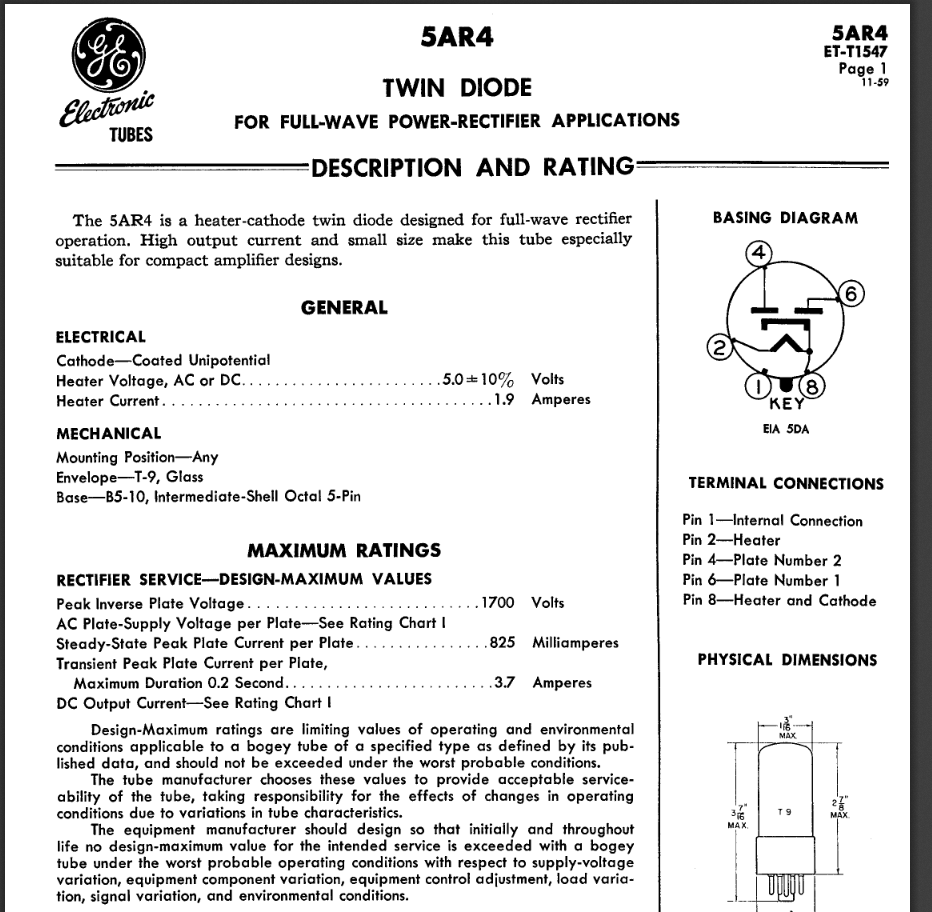
Although GZ34 and 5AR4 are usually regarded as equivalent, the 5AR4 datasheet (at least the GE version) hints at a somewhat tougher tube.
It states 825mA max. forward current, and more important, it allows for a peak current transient of max. 3.7A per plate if the condition persists for less than 0.2 seconds.
Does anyone know if there are any current manufacturers of 5AR4 with those specs?
Regards,
Rundmaus
Although GZ34 and 5AR4 are usually regarded as equivalent, the 5AR4 datasheet (at least the GE version) hints at a somewhat tougher tube.
It states 825mA max. forward current, and more important, it allows for a peak current transient of max. 3.7A per plate if the condition persists for less than 0.2 seconds.
Does anyone know if there are any current manufacturers of 5AR4 with those specs?
Regards,
Rundmaus
Attachments
R, you need to deselect 'soft start' in the options.
Are you sure it should be deselected? Without the soft start option, I would simulate a situation where the HV is suddenly applied to the fully heated rectifier working into empty filter caps - leading to a really high inrush current.
In the actual circuit, the HV is applied to the cold rectifier which slowly goes into conduction while heating up. The voltage on the cathode side of the rectifier rises gradually (measured by DMM) over a period of 2-3s, so the initial current will be lower, as you don't apply the full 400V to empty caps.
Did you measure the transformer primary and secondary winding resistances (for one half of the secondary) and use their calculator.
Up to now, I only measured the off-load voltage vs. the design voltage and used the PSUD calculation to get the winding resistance.
Regards,
Rundmaus
Although GZ34 and 5AR4 are usually regarded as equivalent, the 5AR4 datasheet (at least the GE version) hints at a somewhat tougher tube.
It states 825mA max. forward current, and more important, it allows for a peak current transient of max. 3.7A per plate if the condition persists for less than 0.2 seconds.
Does anyone know if there are any current manufacturers of 5AR4 with those specs?
Regards,
Rundmaus
Be careful. The GE ratings are the Design Maximum values. You can't compare them directly to the more commonly used and more conservative Design Center values such as I've seen on Sovtek, Sylvania, Amperex, and Philips datasheets.
Be careful. The GE ratings are the Design Maximum values. You can't compare them directly to the more commonly used and more conservative Design Center values such as I've seen on Sovtek, Sylvania, Amperex, and Philips datasheets.
Ah, I didn't realize that. Thanks for the hint!
I am a bit curious about the notice concerning temporary current overload. maybe this is the difference between NOS and current production 5AR4...
Regards,
Rundmaus
Rundmaus,
I'd always recommend making winding resistance measurements - as a cross-check, even if they calculate to the same result.
Imho, there is always a reasonable chance of a hot-start for a valve amp, unless you introduce some interlock or means to not allow that situation. All it takes is a quick switch off then back on. The key is then to not exceed the diode's plate transient peak plate current rating.
Choke saturation can be simmed to some extent by reducing the choke inductance value. As a worstcase the L value can be made quite low, but caution is needed when interpreting - not only for the simulated waveform as inductance is not constant, but also the valve's transient rating description.
I'd always recommend making winding resistance measurements - as a cross-check, even if they calculate to the same result.
Imho, there is always a reasonable chance of a hot-start for a valve amp, unless you introduce some interlock or means to not allow that situation. All it takes is a quick switch off then back on. The key is then to not exceed the diode's plate transient peak plate current rating.
Choke saturation can be simmed to some extent by reducing the choke inductance value. As a worstcase the L value can be made quite low, but caution is needed when interpreting - not only for the simulated waveform as inductance is not constant, but also the valve's transient rating description.
Hi there,
the replacement Sovtek arrived and I mistreated the suspect channel with all possible operating conditions, start-up with preheating, cold start, hot restart directly after switch-off and so on...
Neither the first 'good' JJ GZ34 nor the replacement Sovtek 5AR4 show any hint of arcing or overload stress. As the seller is willing to exchange the arcing tube, I will pay the price difference and get another Sovtek, so I'll have the same tubes in both channels.
I will leave it at that for the moment and see how everything works out in the long run.
Thanks for your input,
Andreas
the replacement Sovtek arrived and I mistreated the suspect channel with all possible operating conditions, start-up with preheating, cold start, hot restart directly after switch-off and so on...
Neither the first 'good' JJ GZ34 nor the replacement Sovtek 5AR4 show any hint of arcing or overload stress. As the seller is willing to exchange the arcing tube, I will pay the price difference and get another Sovtek, so I'll have the same tubes in both channels.
I will leave it at that for the moment and see how everything works out in the long run.
Thanks for your input,
Andreas
- Status
- This old topic is closed. If you want to reopen this topic, contact a moderator using the "Report Post" button.
- Home
- Amplifiers
- Tubes / Valves
- GZ34 JJ flashover
